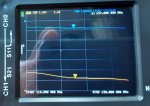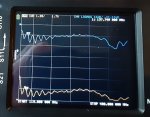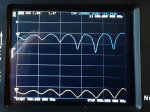digitalanalog
Active Member
From my other massive amounts of testing on the ST-2 antenna and the ST-2 type designed
(the Searcher II)I have been working on, I determined that it would take RADICAL changes
the ST-2 prototype antenna I have been working on to get it into the 200-400MHz range
without jepordizing other bands on the antenna.
So I decided to build a 200-400MHz ST-2 style antenna and build it to ONLY work in that
range 200-400MHz, if it happens to work in other ranges then it's just a bonus, but I did
not care or consider other freq bands, just the MilAir 200-400MHz. (yes i know milair is in other bands)
No front radials of any kind, no connecting rods tieing the sections together, and no wings were required.
(I had a left over main tube from the other antenna design, thats why the extra insulators are there but Not
used, I just didn't take them off.)
75-300 Ohm transformer was used, 75 Ohm RG6 coax was used, Tested using MINI VNA, Calibrated to 75 OHm.
Each element was cut to a specific 1/2 wave length in the spread of 200-400MHz range.
all elements are of different lengths and cut as mentioned to 1/2 wave length dimensions
instead of the typical 1/4 wave length.
I am VERY happy with the results, I have made NO Adjustments to the elements, they are as the
On-Line Wave length Calculator indicated they should be for the range I desired.
The lower end is not as low as I would like and I may try to adjust that, but I have not decided
at this point that it would even be worth it without at least doing to realtime listening on the scanners.


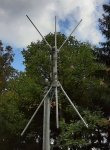
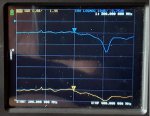
(the Searcher II)I have been working on, I determined that it would take RADICAL changes
the ST-2 prototype antenna I have been working on to get it into the 200-400MHz range
without jepordizing other bands on the antenna.
So I decided to build a 200-400MHz ST-2 style antenna and build it to ONLY work in that
range 200-400MHz, if it happens to work in other ranges then it's just a bonus, but I did
not care or consider other freq bands, just the MilAir 200-400MHz. (yes i know milair is in other bands)
No front radials of any kind, no connecting rods tieing the sections together, and no wings were required.
(I had a left over main tube from the other antenna design, thats why the extra insulators are there but Not
used, I just didn't take them off.)
75-300 Ohm transformer was used, 75 Ohm RG6 coax was used, Tested using MINI VNA, Calibrated to 75 OHm.
Each element was cut to a specific 1/2 wave length in the spread of 200-400MHz range.
all elements are of different lengths and cut as mentioned to 1/2 wave length dimensions
instead of the typical 1/4 wave length.
I am VERY happy with the results, I have made NO Adjustments to the elements, they are as the
On-Line Wave length Calculator indicated they should be for the range I desired.
The lower end is not as low as I would like and I may try to adjust that, but I have not decided
at this point that it would even be worth it without at least doing to realtime listening on the scanners.






